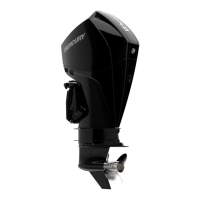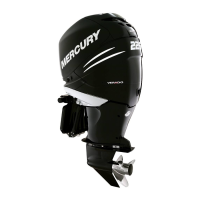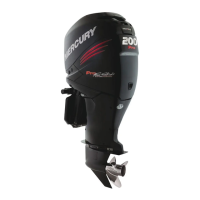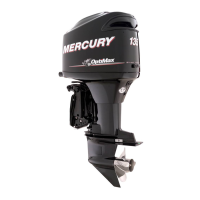Fuel trim
Measured by ITerm values, it is the amount of fuel above or below the expected value that the
engine is adding to achieve stoichiometry or an equivalency ratio of 1.
FWD Forward gear position.
G3 Mercury's latest computer diagnostic system. Also known as CDS G3.
IAT Intake air temperature sensor, alternately known as a manifold air temperature (MAT) sensor.
ITerm
An engineering term describing the percentage of fuel being added or subtracted from the base
fueling number. An ITerm of 0.02 is adding 2% fuel. If the value exceeds a certain number for
that engine (20%) for two key cycles, an ITerm fault will be triggered.
J‑box Junction box, available in 4‑, 6‑, and 8‑way configurations.
Lean Air/fuel ratio greater than stoichiometric (less than 1.000 equivalency ratio).
Main station
On boats with dual operating stations/helms, the station that normally has key switches is
considered the main station, sometimes called the primary station, or helm 1.
MAT Manifold air temperature sensor, alternately known as an intake air temperature (IAT) sensor.
MCA Marine cranking amps, a rating method for batteries tested at 0 °C (32 °F).
Misfire An unexpected change of speed in subsequent power strokes of the engine.
Phi A Greek letter (pronounced 'fee') used to refer to the equivalence ratio.
Port Refers to the left side of the vessel as seen when facing forward.
Pot Potentiometer used in ERC, ESC, and ETC.
Primary station
On boats with dual operating stations/helms, the station which normally has key switches is
considered the primary station, sometimes called the main station or helm 1.
Quad Used to describe an application of four: four engines or four controls installed on the boat.
REV Reverse gear position.
Rich Air/fuel ratio less than stoichiometric (greater than 1.000 equivalency ratio).
Secondary station
On boats with dual operating stations/helms, the station which normally has only stop/start
buttons and no key switches is considered the secondary station, sometimes called the auxiliary
station or helm 2.
Starboard Refers to the right side of the vessel as seen when facing forward.
Stoichiometry
A branch of chemistry that deals with the relations among quantities in a chemical reaction. As it
applies to gasoline engines, it is the ratio of air to gas in the fuel mixture that produces an
exhaust gas that uses all of the oxygen in the process. The ratio is dependent upon the quality
of the fuel. Gasoline with no ethanol typically has a stoichiometric ratio of 14.7:1. Gasoline with
10% ethanol may have a stoichiometric ratio of 14.1:1. Comparing the actual air/fuel ratio to the
stoichiometric ratio, produces an equivalency ratio.
Oxygen sensors measure the amount of oxygen in the exhaust gas and feed this information
back to the PCM 112 to determine the equivalency ratio. If the equivalency ratio is equal to
1.000 the combustion is stoichiometric. If it is above or below 1.000, the system will add or
subtract fuel to achieve 1.000.
Terminator resistor
The DTS terminator resistor is used as a CAN line signal conditioner. The resistor places a
known load on the CAN line to ensure proper communication between the command module
and the PCM.
In a typical single station application, there is one terminator resistor at the engine end of the
CAN line and one at the furthest end of the CAN line near the helm.
Triple Used to describe an application of three: three engines or three controls installed on the boat.
Troll control
Sets and controls the idle speed of the engine for trolling without using the throttle (System
Tachometer and Speedometer).
UEGO Universal exhaust gas oxygen sensor.
Warning system
During an event that may damage the engine, the system sounds the warning horn and
SmartCraft gauges display the warning message.
Weather cap Provides protection on unused connections.
Glossary, Reference Charts, and Conversions
90-8M0146617 eng JULY 2018 © 2018 Mercury Marine Page 1D-3

